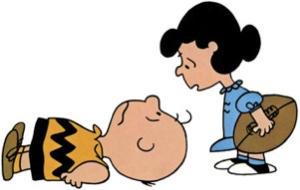Category Archives: Essays
I suspect that I did not play Firewatch at the pace it expected. In retrospect, I approached the game as a dual role-playing exercise, in unwitting partnership with the actor Rich Sommer, who so memorably provides the voice of player-character Henry. While I did love participating this unusual sort of time-displaced acausal improv, I may not have kept to the trail the game had marked for me, to my own detriment.
An earthy dude in every respect, Henry spends the whole game in radio contact with an off-screen colleague, and makes his opinions, desires, and emotional state all entirely transparent. Which is not to say blunt — Sommer portrays him with subtlety and sincerity. Henry is just not a man who hides his mood. And that mood is often I have to go do this thing, now.
I always took this, willingly, as a cue to hustle. While the game always tempts you to explore the woods freely using Henry’s (entirely diagetic) map and compass, doing anything other than making a beeline to his next goal would have felt like the letting the backside of the pantomime horse drag his feet while the front surged ahead. Despite my suspicion that the game would have allowed me to put Henry’s concerns on hold as long as I’d have liked to instead have him investigate odd spots on the map, the thought of it just didn’t feel right. Onward!
In so doing, though, it seems that Henry and I hiked right past a lot of interesting stuff, there in the game’s recreation of the Wyoming wilderness. Shortly after I finished the game, a friend asked whether I’d found the elk, a detail that a lot of players had apparently overlooked. No, I hadn’t found the elk. Today I learned that there’s a turtle of some interest elsewhere within the game, and a cabin. I did not find any of these things. I do not mind that I didn’t! I seldom obsess over “one-hundred percenting” games; I play until I feel done, and the ending Firewatch handed me felt like enough.
However, the fact that I did jog past all these sights made me reconsider how the presentation of the game’s story seemed unusually out of sync with my experiencing and processing of it.
Early on, we see some unsettling things, and we hear reports that people we’ve met earlier are missing. Presently, the main character becomes convinced that strange and terrible events are afoot, and that he or others might be in imminent danger. Shortly into the mid-game, these concerns become interleaved with a “B-story” regarding a boy and his dad who used to camp often the woods, long prior to the player-character’s arrival.
If I sound uncertain about these latter characters, it’s because I started learning about them while my focus as a player remained entirely on the tension of the “A-story”, all the scary stuff and unnerving encounters. I wanted to follow those, and see what happened next! The game, on the other hand, wants the player’s focus on the first thread to cleanly dissolve into the second, just in time for the reveals near the end of the story.
Unfortunately, it didn’t quite work out that way for me. My Henry, in his hurried pace, started putting two and two together far sooner than I did, and began to speak his conclusions out loud while I was still jumping at shadows and thinking “Wait… who are these guys again?” The given denouement made sense, I suppose, but I still felt like I’d missed some important cues, despite my earlier efforts to closely wear the role.
Interactive narrative is hard, and interactive narrative that leaves pacing in the player’s hands — tying it to an explorable map, in this case — presents its own unique challenges. While text-based interactive fiction sits on decades of examples, beautiful, accessible, visually immersive “walking simulators” like Firewatch have only begun to figure it out for themselves. I very much look forward to more work like it.
As I noted in my previous post, my partner’s brother surprised us last month with the Christmas gift of a PlayStation 4. This machine has surprised me in turn by rekindling my interest in video games, more than a year after various events left me feeling deeply ambivalent about the medium and much less interested in writing about it. (I did, during this time, launch a different blog, where I write about books and movies and conferences such.) After a long break, I feel like I have a few new things to say about digital games.
I in particular feel very pleased with the many ways that PS4 games have demonstrated new ways of approaching networked multiplayer games, a topic of everlasting interest and much-historied heartbreak for me. Several years ago I pledged to permanently dial down the attention I gave to solitaire video games, but my success with this initiative has proven varying, at best.
To my frustration, I found multiplayer gaming on my long-preferred platform of the Xbox 360 a non-starter. With the exception of shooters, which I don’t really enjoy (my flirtation with Team Fortress 2 a sadly brief anomaly), I never saw an Xbox game with a truly viable multiplayer mode, even though so many tried. (I even launched a startup trying to singlehandedly repair this fault, and it, too, foundered.) I had more fun playing Hero Academy on iOS, at least for a while, until its asynchronous turn-pacing began to grate. And over the last three years or so I’ve enjoyed phases of temporarily waxing interest in Guild Wars 2 on my Mac, but found that playing it “properly”, as part of a focused and organized MMO guild, demands far more attention over a much longer span of time than I feel able to invest.
All this left me with no idea that the situation on PlayStation would prove so different! I have written about Everybody’s Gone to the Rapture, so far the only PS4 game I’ve sampled which lacks multiplayer activity as a core mode or mechanic. Well, no, not quite: We did feel compelled to purchase Fallout 4 as soon as we could — but have not felt compelled to play it much, yet. When I do fire it up, I recall how Fallout 3, in large part, made me originally swear off single-player overexposure, and I cannot resist the call of the far more immediately interesting and thoroughly networked games installed on our console.
I hope to write individually about the many novel multiplayer angles I experience through this new exploration, but I feel I should begin by revealing that I have — at last! — played Journey, first released by Thatgamecompany in 2012. From there it swiftly became part of the canon, where I do believe it will live a long, long time. Zarf described its famously subtle multiplayer mechanics in a Gameshelf post from the end of that year, so I knew about that going in. I also knew how the game limits your direct communication with other players to only the controller’s ⭕-button, which makes your character emit a glyph while sounding a musical note. (I read this as the character speaking their name out loud. Names, and the speaking of them, resonate throughout Journey’s such-as-it-is story.)
The approximately two-hour experience still left a deep and I dare say permanent impression on me. Many days later, I remember key details of my journey very well, and two things strike me about them. First, they belong to me alone, among all the players of Journey, even though in broad strokes we all took the same trip. And this fact was made possible entirely through the way Journey’s multiplayer mechanic works.
When I asked the internet what I should play on the PlayStation 4 we got for Christmas, Sam Ashwell immediately suggested The Chinese Room’s Everybody’s Gone to the Rapture. Over the last week my partner and I played it across three sessions. I ended up finding it hard to process, not due to its content (which I rather enjoyed) but because it just seemed an overall unlikely artifact.
I didn’t carefully time it, but I think it took between six and eight hours to stride through, not playing as a completionist. I did try to trigger as many location-dependent story points as I could, but found that the player-character’s relaxed walking speed, inherited perhaps from the team’s previous effort Dear Esther, discouraged obsessive searching through every nook and cranny of the map.
The game invites you to explore the many interpersonal dramas within a modern English hamlet whose inhabitants possess various degrees of realization that the world’s coming to a sudden end. (No spoilers here — the title’s a little oblique, but only just a little.) Your lonely wandering occurs sometime after all the people have inexplicably vanished, leaving behind ghostly echoes of their conversations, fights and trysts across the eerily empty fields, homes and pubs. I found it reminiscent of the films Melancholia or Life After People, albeit married to the narrative conceit found in games like Bioshock (while leaving all its gunplay at the door).
I’ll have more to write about the experience of playing contemporary video games on the PS4 later, but allow me to say now that I spent much of my time with Rapture just… confused that humans had managed to build this. That seems very small-minded of me, as someone who has experienced Stendhal Syndrome in the presence of certain real-world architecture. Rapture didn’t make me weak in the knees, though; my wonder more resembled that of watching a master magician, perhaps, performing impossible actions at a personal scale. In the game I would make my way through a field of tall, rustling wheat stalks and into a shed, and stare straight up at the metal corrugated roof, noting the spattering of rust around its uneven seam. Like so many other things and structures in the game, the shed narratively served only as set-dressing, with no rules-mechanical purpose at all. I’d think about the effort it took to build this shed inside the game world, and how I’d leave it soon and never see it again. And I’d just think: how?
I mean, I know the basics of the process that must have gone into that shed. Initial design documents describing the fictional village of Yaughton and its adjacent farmland would have led to field research in the real world’s countryside that found and photographed, among many other things, little sheds with corrugated roofs. These would ultimately become amalgamated into a single digital shed built through the same processes of painstaking modeling and QA testing that the studio applied to every other object and structure found within the game. I get all that.
But as “I” stood there in the shed inside this game, staring at its ceiling, I couldn’t escape the feeling that it shouldn’t exist. None of it should have existed. On the aesthetic level alone, it seemed too beautiful and fragile to exist within the medium of video games. I hate how hokey that sounds, and I dislike how it sounds like I call the entire game a masterwork for the ages, because I’m not sure I would. The “player is a silent, invisible specter exploring a beautiful but lifeless world littered with talking books or audio diaries or whatever” setup is very well-trodden ground, and to say that Rapture does something new with it isn’t necessarily saying much at all.
It made me feel regret all over again for not visiting Sleep No More during its lengthy run in Boston, because I now very much wish to compare my feelings about exploring the spaces offered by the two works. I suspect I would find them both similar in their extreme unlikelihood, and yet in both cases: here I stand, inside them.
Let us leave the shed and return to the story. The very end of the game presents a tonal shift different from all that came before. At the closing credits rolled, my partner said, “That was confusing.” I didn’t disagree, and some hours into the following day, while she worked at her job and I sat around the house thinking about very slow video games, I composed for her an email writing out my take on the ending, and all else that the game’s last half hour or so reveals. And this follows.
Please note that the remainder of this post spoils the story of this game, and won’t necessarily make much sense if you haven’t played it, besides.
For the past few weeks, my partner and I have been striving to get out of house more, a tonic against the crushing isolation of Newport in winter — made all the worse on us as newcomers with few local friends. A couple of weekends ago we attended a board game meetup at my favorite local coffee house, our first such event since leaving our Boston-based circle of tabletop-loving friends. We didn’t know anyone there, and had a great time.
In the same vein, and at the same time, I decided to finally try Ingress. More than one friend of ours treats this game as a significant personal pastime, and I’d felt curious to examine it for months just from my usual semi-pro game-studies perspective. Ingress presents itself as an augmented-reality game that gets you exploring your neighborhood in a new way, and I imagined something like Geocaching: the RPG. It seemed like just the thing to escape a wintertime rut, at the cost of stomping around through snow and sub-freezing temperatures.
Well: the game is ostensibly like that. I had terrific fun for the span of a single weekend, but it ended up souring on me quickly. Before a week had passed, I had deleted the game from my phone, and found the willpower to keep it off. My problems with Ingress stemmed from how I found myself unable to stop playing the game. I don’t refer to addictive, repetitive play, here, even though it does involve a bit of level-up grinding. Rather, I mean that I felt literally unable to enter a state where I was not playing Ingress. I would put my phone away, I would get back to work, and yet I was still playing Ingress. I found this total bleed-through of game and life initially novel, then uncanny, and finally uncomfortable, especially once I started interacting with other local players. This culminated in an angry and cowardly action my part, the last thing I did within the game world.
Before describing this negative effect any further, I shall describe three inarguably positive experiences I enjoyed via Ingress during that first weekend.
No video game I have played as an adult has affected me as profoundly and personally as Telltale Games’ The Walking Dead has. I’ve already written about my technical admiration for Telltale’s interactive television dramas (whose titles have doubled in number between the date of that essay and just this week), but now I wish to get personal. This may take more than one post.
The rest of this post contains spoilers for seasons 1 and 2 of the “Walking Dead” video game.
Tags: digital games, telltale, walking dead.
This post contains spoilers for the film “Gone Girl”.
I managed to catch Gone Girl during its last days in the first-run theaters. I feel glad that I did; it’s a stylish film, what I think of as a Fincher/Reznor collaboration (per The Social Network) where the latter’s synthesized instrumental score is nearly a character unto itself, stepping into the foreground during the tensest scenes, playing as important a role as the actors’ spoken dialogue. I liked that.
The film’s content, though, I feel less unqualified admiration for. Maybe this is informed to some degree by the coincidence of the title’s initials, but it struck me as a film quite in step with GamerGate’s anti-feminist, even gynophobic philosophies. Gone Girl’s story takes place in a world where women actually do the awful things that GamerGate accuses its own female harassment-targets of. I couldn’t help but see it as a window into the mind of men who are petrified with contemplation of the life-upending terrors they fear women as having the power to perpetrate.
Tags: movies.
 The publisher itself doesn’t market them this way, and I haven’t run across anyone else applying the label. So, from my own perspective, let me say it first: Telltale Games’ most recent narrative video games, including The Walking Dead and The Wolf Among Us, have realized the ancient dream of true interactive television.
The publisher itself doesn’t market them this way, and I haven’t run across anyone else applying the label. So, from my own perspective, let me say it first: Telltale Games’ most recent narrative video games, including The Walking Dead and The Wolf Among Us, have realized the ancient dream of true interactive television.
By this I don’t mean TV shows with audience call-in gimmicks attached, or experimental games delivered via broadcast television, or similarly venerable exercises of the medium. I mean an evolutionary application of contemporary television storytelling techniques to the naturally interactive environment of video games to create something entirely new, and deeply interesting.
Tags: digital games, television, telltale.
When the excellent internet-culture podcast TLDR tweeted a couple weeks ago that its new episode featured an interview with someone who witnessed her persona within a certain video game get sexually assaulted by other human players, I had an immediate guess which game they’d name. I was right: the incident occurred in DayZ, a popular MMO with a nominal post-apocalyptic survival theme.
My knowledge of DayZ is quite limited. I’ve never played it. I have had one friend, a inveterate fan of actual role-playing in online RPGs, regale me at length about all the time she’d spent there with an online improv group, experiencing varying success at playing out story-games in its setting. When the game got a wider release on Steam last year, I read a long comment-thread on imgur about all the goofy ways new players had died, with a strange focus on other players force-feeding them rotten fruit or drain cleaner.
And then, earlier this year, I discovered this video, following a link describing it as something amazing that happened in the game. With my lack of knowledge about typical interactions in DayZ, and otherwise not knowing what to expect (outside of the video’s title), I found the first 40 seconds — which isn’t supposed to be the amazing part — very stressful to watch.
Those 40 seconds contain one of the most violent exchanges I have ever seen in a video game, even though (modulo some casual language) the incident, if dramatized on film, wouldn’t rate more than a PG in the US. In one sense, it’s just two men talking; neither so much as lays a finger on the either.
The third man who shows up at the 40-second mark is the star of the video, and immediately changes the tone in an unexpected and genuinely impressive direction. But from context, I take it that one player brandishing a gun and verbally instructing an unarmed player to kneel, humiliated, is such a typical interaction in the game that it doesn’t even bear comment. This video uses it as mere stage-setting; one gets the impression that if the third character hadn’t appeared, this player wouldn’t have bothered posting this video.
Tags: dayz, digital games, mmos, violence.
I still love Hero Academy from a design standpoint, and nothing will undo all the fun and fascination I had with it in 2012. I bagged the 40-wins achievement towards the end of that year and I still feel good about it. Once iOS-exclusive, the title now makes itself available across all significant desktop and mobile platforms, and I continue to encourage folks interested in the overlap of tabletop and digital games to check it out, for all the reasons I wrote about back then.
I last month dipped back into it and ended with only disappointment, though — not with the work itself, but with my own failure to see a single game through. I happily launched myself into four simultaneous games, much as I would have a couple of years ago. After a flurry of initial activity in each, though, I allowed all to lapse into default over the holidays. By not registering any moves during the 14-day limit, I automatically and tacitly sent my friends home with rather toothless victories.
Time was I loved games that moved at the pace of correspondence, taking days or weeks to play out, but I don’t believe it true any longer. I’d like to try examining why this may have come about.
 Beyond being a surprisingly well-written entry among Traveler’s Tales’ more recent Lego-Whatever titles, Lego Batman 2 may contain the most poignant expression I’ve seen of Superman’s perhaps most obvious narrative problem: how does one make a literally omnipotent character dramatically interesting? What does it mean when there’s this one guy always front-and-center who can outdo any individual, super-powered or otherwise, at whatever thing they feel makes them special?
Beyond being a surprisingly well-written entry among Traveler’s Tales’ more recent Lego-Whatever titles, Lego Batman 2 may contain the most poignant expression I’ve seen of Superman’s perhaps most obvious narrative problem: how does one make a literally omnipotent character dramatically interesting? What does it mean when there’s this one guy always front-and-center who can outdo any individual, super-powered or otherwise, at whatever thing they feel makes them special?
Lego Batman 2 shines a spotlight on these questions in the very best way a videogame can, purely through play mechanics, and with reserved brilliance. Much like the first (much weaker, far buggier) Lego Batman game, the first few acts of the story mode lend Players One and Two the unsurprising respective roles of Batman and Robin. At the start of the second act, the plot twists in such a way that the latter finds himself bumped into the wings when Superman swoops into the Player Two spot. And then things get interestingly weird.
Tags: comics.
A question from the blog-topics backlog which I’d now like to throw out to the readership: If you have ever played a combat-oriented tabletop role-playing game like Dungeons & Dragons, did you ever actually use miniatures on a grid, as the rulebooks generally assume of their players, with each square representing a 10’-by-10’ area? Or did the combat, as with the rest of the gameplay, stick to an entirely verbal format?
Tags: d&d, rpgs, tabletop games.
I enjoyed Gone Home. The rest of this post is full of loose and extremely spoiler-filled thoughts about it.
Sometime in the latter midgame of Bioshock Infinite, I happened to notice that an archway I was about to scoot under was decorated with little bas-relief cherubs. Slowing down my usual breakneck pace through the map, I tilted my view up as I walked under the arch, and observed that, yes, the cherubs were fully three-dimensional, not simply a shadowed texture painted onto a flat surface. Someone at Irrational had taken the time to carefully model this sculpture and place it at this one spot in the game world.
What a shame, I thought.
Playing Bioshock Infinite reminds me how much I wanted to write about I Am Alive, a game I finished earlier this year and found both easier to enjoy and quite uniquely thought-provoking. So let’s do that now.
This Ubisoft-produced survival-horror game appeared as a downloadable console title last year to little fanfare (which is to say, nobody on my Twitter timeline had much to say about it), and I bought it on a hunch, putting it aside for later. Even though it took me another year to actually pick up and play through, I found I Am Alive a delightful and rewarding surprise. While the game’s narrative isn’t spotless, I found the script and voice acting very good, and think the game explores genuinely new directions for survival-horror games in terms of both mechanics and story.
Let me describe here what I especially liked about the mechanics, because that’s the easy part. I hope this’ll be a warm-up for the narrative stuff, which I expect to have harder time writing well about. The game is about a man searching through a destroyed city for his family, and among the various situations he faces while under the player’s control are frequent encounters with opportunistic ruffians. That’s the bit I want to talk about here.
Tags: combat, digital games, i am alive.
 I strikes me as a bit counterintuitive that I would enjoy Derek Yu’s Spelunky as much as I do, while I remain estranged from Dark Souls. Aren’t both games super-cruel dungeon crawls, presenting maddeningly difficult challenges while swiftly and severely punishing the slightest error? Perhaps, but they do so with practically opposite attitudes towards the player, a difference suggested by — but much deeper than — the two games’ radically different aesthetics.
I strikes me as a bit counterintuitive that I would enjoy Derek Yu’s Spelunky as much as I do, while I remain estranged from Dark Souls. Aren’t both games super-cruel dungeon crawls, presenting maddeningly difficult challenges while swiftly and severely punishing the slightest error? Perhaps, but they do so with practically opposite attitudes towards the player, a difference suggested by — but much deeper than — the two games’ radically different aesthetics.
Tags: dark souls, digital games, spelunky.
Robot Entertainment’s Hero Academy is my favorite new videogame of 2012, and far and away the best original-to-platform tabletop game I have enjoyed on iOS. I have felt more intense highs and lows playing this strictly player-versus-player game than any other videogame of the last year, to the point where it rekindles my interest in tablet games and their potential for great multiplayer experiences. Beyond that, I admire the publisher’s sales approach, and hope that it becomes a model for other game studios to follow.
On reflection, the fiero that fills me when a Hero Academy sally goes well (and the hunger for same I feel when things go badly) is identical to the thrill of a face-to-face boardgame that’s really engaged my attention. I credit this to Hero Academy’s various smart design nudges that make starting (and, subsequently, managing) games with real-live opponents a pleasure, doing it better than any cardboard-to-digital adaptation I’ve seen so far. It helps remind me why I tend to treasure my experiences with great multiplayer games far more than any solitaire game.
Tags: hero academy, ios, ipad.
 This post contains minor spoilers for Fez, but only if you deliberately decipher them.
This post contains minor spoilers for Fez, but only if you deliberately decipher them.
Yesterday I asked this question on Twitter:
Fez hint request: Jbhyq vg or jbegu zl gvzr gb gel qrpvcurevat gur jevgvat (abg gur ahzoref) nf n fvzcyr pelcgbtenz? rot13.com
I have asked spoiler-class questions about games, films, or books in this format before, usually to little response. In retrospect, it’s clear that I assumed too much in expecting any friend or follower to see it as anything other than gobbledygook. In yesterday’s tweet, I tried an extra step with appending that URL, and to my delight received several nice replies on Twitter and Facebook — as well as a handful of retweets, which I read as compliments on my chosen encryption method.
Some of my correspondents on Twitter chose to adopt the same encoding. “Anu,” advised one reply. “Pbairefvba vf cerggl enaqbz.”
“V’z gbyq gung gur jevgvat vf n fbeg bs zrgn-chmmyr,” countered another, “fb lrf.”
 As I have done every year since 2004, I spent the second weekend in January playing (or solving, to use the field-specific lingo) in the MIT Mystery Hunt. I always feel quite privileged to play; each hunt iteration represents a one-time-only interactive artwork that a team of passionate amateurs spends the better part of a year planning and constructing, culminating in a single weekend where a thousand puzzle-hungry solvers trample through it.
As I have done every year since 2004, I spent the second weekend in January playing (or solving, to use the field-specific lingo) in the MIT Mystery Hunt. I always feel quite privileged to play; each hunt iteration represents a one-time-only interactive artwork that a team of passionate amateurs spends the better part of a year planning and constructing, culminating in a single weekend where a thousand puzzle-hungry solvers trample through it.
Like an informational World’s Fair, it leaves its husk behind for the late-but-curious to tour: you may browse all this year’s puzzles online, and note that they seem to be arranged around a theme of ill-advised Broadway mashups. Without the context of the hunt alive around them, though, the puzzles lose a certain amount of motive force. When presented all at once like this, they lack the light but necessary hunt-specific narrative that organizes paths for the solver to follow. (This year, it featured a storyline based on the further adventures of the swindling showmen from The Producers.)
I would also argue that, even though each puzzle now links to its own solution page, these puzzles must still seem impossibly obscure to curious layfolk who stumble upon them. So in this article, rather than examine the hunt’s overall form where carefully paced groups of puzzle-sets slowly reveal the twisty superstructures of meta-puzzles, I’d like to highlight a few of the several dozen individual challenges which defined the weekend for the hunt’s players.
Let’s start with the puzzle titled Slash Fiction, designed by (and starring) Seth Schoen and Vera Yin. It makes a nice blog-post headliner because it happens to take the form of a six-minute video, one as fun to watch as to solve.
Have you watched it? All right, then: your challenge, as with every hunt puzzle, is to somehow definitively produce an English word or phrase based on this input.
Tags: mit, mystery hunt, puzzle hunts, puzzles.
 I’d like to follow up on that last post about Dark Souls, providing a little more context for my reaction. While it occurred against a backdrop of environmental stress that was probably incompatible with such an unusually demanding game, I find the real trigger to lie with a single, curiously underreported feature of this work.
I’d like to follow up on that last post about Dark Souls, providing a little more context for my reaction. While it occurred against a backdrop of environmental stress that was probably incompatible with such an unusually demanding game, I find the real trigger to lie with a single, curiously underreported feature of this work.
No essay about Dark Souls I encountered before this week has mentioned its lack of a pause button. Pressing start on the controller summons up an equipment-swap overlay where you can futz around your character’s belongings in typical RPG fashion, but it does not stop the in-game action. The only way to make the game halt, even temporarily, involves quitting it entirely.
Thus, if the doorbell rings while your character is under assault and in danger of losing all your recent progress, you will have a certain choice to make. I found this design decision first perplexing, then fascinating. It seemed devilishly in-keeping with the game’s overall attitude of reward for those who learn to play by its rules, and utter disdain for anyone else. Oh, I’m terribly sorry, says Dark Souls to the player looking for the pause button. I thought you had come here to play. Clearly, I was mistaken. I do apologize. Why don’t you come back when you’re ready?
Tags: dark souls, digital games.
 Last semester I found myself needing two copies of Xbox Left 4 Dead so that we could study that game in class. I already owned one, and feeling too lazy to requisition another from the university, I arranged a temporary trade for a friend’s copy. He requested Dark Souls in exchange, having observed my copious tweeting on that topic a few weeks before. The semester’s over now, and my friend had quickly found that Dark Souls wasn’t really his cup of tea. I’ll propose a lunch to reverse the exchange sometime, but I’m in no particular hurry: I don’t really want to see Dark Souls in my house again, let alone in my game console.
Last semester I found myself needing two copies of Xbox Left 4 Dead so that we could study that game in class. I already owned one, and feeling too lazy to requisition another from the university, I arranged a temporary trade for a friend’s copy. He requested Dark Souls in exchange, having observed my copious tweeting on that topic a few weeks before. The semester’s over now, and my friend had quickly found that Dark Souls wasn’t really his cup of tea. I’ll propose a lunch to reverse the exchange sometime, but I’m in no particular hurry: I don’t really want to see Dark Souls in my house again, let alone in my game console.
To say I don’t like the game would be an oversimplification bordering on falsehood; in fact, the game brought me many hours of enjoyment, and I carry lasting fond memories of certain gameplay moments. As reports from friends filter in that they are finally finishing the game (it takes upwards of 100 hours to traverse), I think back to these moments, and the chance that I’ll give it another look someday rises above absolute zero. But this can’t happen in the near future: my relationship with this game ended so disastrously that it’s really better for both of us to avoid contact for a long time.
I must risk sounding melodramatic to explain why this game so profoundly unsettled me: I had never felt such purely negative emotion about a videogame in my adult life as I did at the moment when Dark Souls betrayed my trust.
Tags: dark souls, digital games, jmac on games.

